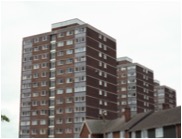Being born on a London estate gave me the opportunity to see an entirely different way of life and community culture than what is normally expected of in the capital. An estate in London has an incredible amount of similarities and differences to a slum in Pune or Mumbai. Both represent the poorest and most underprivileged members of their own separate societies yet still represent core community values in which differs from the cities they are situated.
Similarities
Community
Firstly, when you take into consideration the geographical situation of both places it would be fair to assume that everyone went about their lives, day-to-day, 9 to 5; earning money for their families and being pretty independent. However, Both the estate and the slums are completely different to their hosts cities. The hustle and bustle of London and Mumbai/Pune doesn’t affect the community culture in both places.
Both in the estate and slums, everybody knows each other and everyone cares for one another to some degree. They all get involved together with the current affairs and they are all so connected to one another. All the children from both communities regularly create life lasting friendships with one another and grow up simultaneously despite age gaps. Sport is present in both environments and again unites the people especially football in the estate and cricket in the slums.
Density
Both communities are extremely densely populated areas. Where the differ in the way they utilise the land they occupy – e.g. Slums use more landscape horizontally as opposed to estates which utilise the landscape vertically – but they both house an extreme amount of people for a small amount of space. The other day we stumbled upon a slum in Pune and the residents stated that over 15,000 people lived there. This compares to the Alton Estate in Roehampton in South West London, which house a staggering 13,000 residents.
Crime
When there is a concentrated amount of poor people in one area it is most likely to come hand in hand with a fairly high crime rate. In India, rape is considered one of the most common crimes in the slums and I learned that rape cases have doubled between 1990 and 2008, with an average of 2.8 victims per 100,000. Comparing this to the estate where knife and gun crime is rife and a major problem for the city. In London knife crime is up by 18% with 16 people becoming victim to it per 100,000 people.
Differences
Standard of Living
One major difference is the difference between wealth. Those who live in the state have a much higher earning wage and standard of living than those in the slum. With the National Living and Minimum Wage increasing to £7.20 an hour, those in the estates have a much easier financial life than those in the slums; who live on as low as ₹40 a day. Also, those in the London estates are able to claim for housing and childcare benefits whereas this is a complete impossibility in India. And finally, unemployment is extremely high in the slums due to lack of any education. This causes many citizen to have extremely low paying and low ranking jobs. In some cases, children are asked to work in order to help afford food. These are all problems that those living in housing estates are a complete world apart from.
Attitude
I believe the attitude in housing estates are extremely poor. A lot of those in the housing estates choose crime, benefits and alcohol/drugs over working hard and pushing on for a better life for yourself. Although this may slightly be the case in Indian slums, it is too my knowledge (and several local peoples knowledge) that this is just not an option. And those in the slums work 10x harder in order to achieve a much better standard of living as there is just no other choice. This is exemplified in the programme the Indian Government runs in which it grants a person at least 100 hours of employment in a year earning ₹150 a day. The local people of the slums jump at this opportunity in order to work, survive and gain skills that will further help them change their living circumstances. On the contrary to this, I believe that if this very same programme were transported to the UK, many of the residents of the housing estates would shun such a low wage, for such gruelling hard-work; and would remain content with receiving benefits and staying unemployment. I feel this attitude difference is attributed to the privileges are government is able to grant us.
Diversity
Finally, I believe that diversity in a London housing estate is considerably more vast on an international scale than that of an Indian slum. Many people from all over the world live in housing estates ranging from Africans, Europeans, English nationals and Asians (Indian, Chinese even Filipino). This is far contrasting to an Indian slum where the majority of the residents are just Indian. There may be a lot of regional, national and maybe religious diversity in the slums but nothing comprising on the global scale like London. I feel this is down to the fact India is a very densely populated closed country, boasting an estimated population of 1.252 billion.
